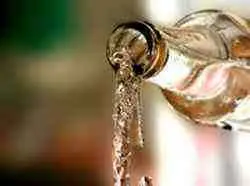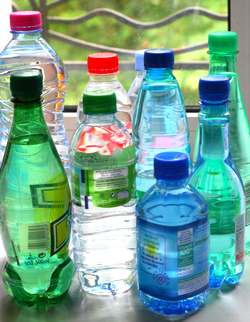French Bottled Water
French bottled water is shipped all over the world. If you don't live too far off the map, you probably can find some in your local grocery store. These waters come from different places in France and each has its own distinct taste and mineral composition. It can be helpful to know a little about the source of these waters before investing your money in a bottle.
Drinking Water In France

- Eau de table - Table water. This is the same potable water that comes out of the tap, but it has been bottled for sale. In France, the tap water is strictly controlled for toxins and is treated for pathogens. Many people consider this to be the best tasting and healthiest water available.
- Eau de source - Spring water. For the most part these waters do not come from a natural spring, but from a well. They do not have to present a consistent mineral profile and indeed a particular mark could come from different sources. Unlike eau de table, they can not be treated with chemicals, so they must be naturally potable.
- Eau minérale naturelle - Natural mineral water. These waters must come directly from an underground source and present a consistent mineral profile. Just as with an eau de source, they can not be chemically treated. These are the French bottled waters you will typically found shipped around the world.
Mineral Content and Health
Most French bottled waters are high in magnesium and contain varying amounts of calcium, fluoride, and even sodium. There are some mineral waters that are not appropriate for regular consumption because their mineral content is so high it may present a danger to your health if you drink it to the exclusion of other waters. It is a good idea to vary your source of water in any case.
Bottled water consumption is actually leveling off in France after many years of increase. This is perhaps due to a saturation of the market, but it is also possible that people are becoming concerned about the environmental costs of transporting water across the country (and all over the world). These days a good eco-citizen probably drinks filtered tap water.
My suggestion to you is to enjoy French bottled water on occasion. Just like wine, a good choice of water can compliment a meal. You can also be on the lookout for unusual bottles. Many of the mineral water producers come out with year end special edition bottles that can add a fun French sparkle to your table.
Carbonation
Some French bottled water is naturally carbonated. That is great isn't it? The earth gives us bubbles too! Most times the natural carbonation is removed and then put back in to create a consistent product.
French Mineral Water Brands

In the history of France, water therapy known as thermalism has played an important role in health care. Many of the popular brands of water are bottled on sites of former water Meccas and in the surrounding towns you will find traces of their glory days. Some of these towns still sport a thriving industry of health spas.
I will not bore you with a complete list, but here are a few of the more well known brands of French bottled water:
Badoit
This is a naturally carbonated water that is fairly high in magnesium. It is bottled by Danone and comes from sources in the town of Saint-Galmier in the Rhône-Alpes region of France. You can find Badoit that has mint and lemon flavoring added. Badoit feels only lightly carbonated - the bubbles are small, and the taste is fairly neutral. For me, this is a great water to have with just about any meal.
Contrex
In France, Contrex has long been marketed with the jingle "mon partenaire minceur" (my slimming partner). Nestlé has tried to appeal to a dieting audience by vaunting the virtues of drinking a water which is high in magnesium and calcium. Contrex flows from sources in the Vosges mountains in the region of Lorraine. I find it to be a very pleasant tasting water, but with the high calcium content it is one of those waters you probably don't want to make your exclusive drink.
Evian
One of the most famous and popular of French bottled waters, Evian flows from sources in the Alps in the department of Haute-Savoie. It has a very low mineral content making it a safe water to drink on a daily basis. Danone is continually reminding us that it is the perfect water to give to our babies. This is a very neutral tasting water and I would characterize it as having a softness which must be a result of its low mineral content. All in all, a rather bland water!
Hépar
Another member of the Nestlé group of waters, the source for Hépar is quite near that for Contrex and Vittel in the Vosges mountains. It is conditioned at the same site as Vittel. Hépar is similar to Contrex with a high mineral content and a similar taste. Best for drinking on occasion, perhaps when you feel the need for a little mineral boost.
Orezza
This is actually a lesser known water, but I just had to mention it as I have visited the site of its production in Corsica several times. It is a naturally carbonated water that is notably high in iron. The source of Orezza is in the heart of a chestnut forest a little up in the mountains in the north of Corsica. It is a magical site, tucked away from the hubbub of the modern world. If you are ever in Corsica, you really should not miss it. Great tasting water needless to say!
Perrier
Along with Evian this has to be France's most famous water. Perrier comes from sources in the region of Languedoc-Roussillon in the south of France. It is naturally carbonated and the bubbles are frankly aggressive. Perrier is available in all sorts of flavors and there is even a less carbonated version known as eau de Perrier. For me this is best drank on its own, perhaps enjoyed at cocktail hour as an alcohol substitute.
Saint Yorre
Another naturally carbonated water, Saint Yorre distinguishes itself in its very high bicarbonate content. This allows the company to promote this French bottled water with the notion that it is the perfect accompaniment to meals. It has a distinctly salty taste that either you are going to like or may just leave you feeling thirsty. It is bottled in the same area as Vichy
Quézac
Yet another Nestlé product (do you see a pattern here?), Quézac comes from a naturally carbonated source in the Languedoc-Roussillon region. The carbonation is first removed along with some iron, and then the carbonation is added back in. A frankly fizzy water, similar to Perrier which comes from the same area.
Vichy Célestins
This is similar to Saint Yorre, and indeed the two come from the same area in the Auvergne region. It too has a high sodium content. By the way, thermalism is alive and well in modern day Vichy.
Vittel
Although it contains a fair bit of calcium, Vittel is considered to be low in minerals. Nestlé bottles this one too and the source is near that for Contrex and Hépar in the Vosges mountains. Indeed there are pipelines connecting the sites of production. It is fun to see that even though two sources may be quite nearby, they can produce considerably different sorts of water. This probably makes a good everyday drinking water.
Volvic
This is my favorite for everyday drinking. This water has a nice taste but is low in mineral content. It is bottled by Danone and comes from the department of Puy-de-Dôme in the Auvergne region, a volcanic area that brings us the tiny green Puy lentil as well.
Go from French bottled water to French Wine Champagne.
Return from French bottled water to French Foods.

New! Comments
Have your say about what you just read! Leave me a comment in the box below.